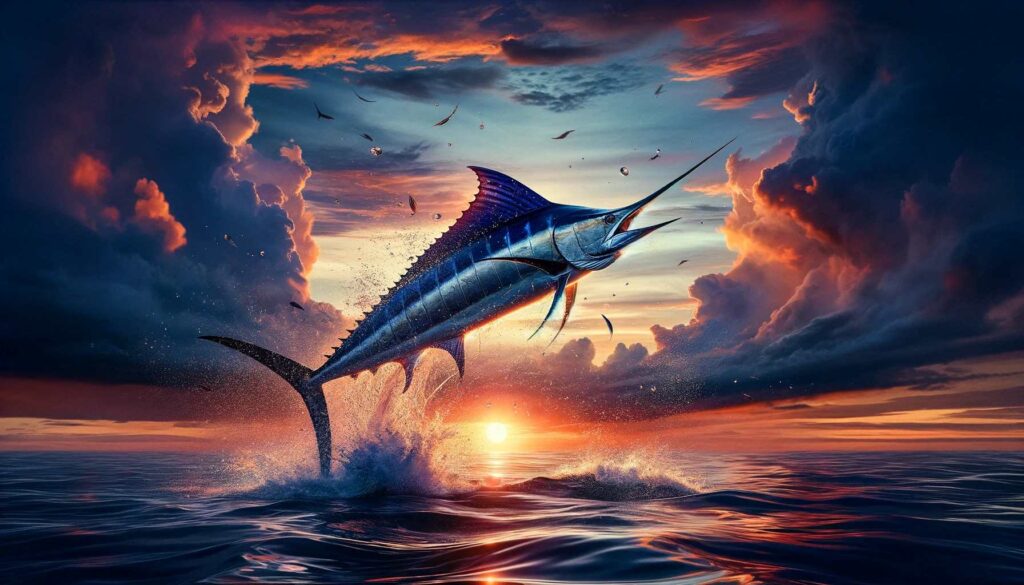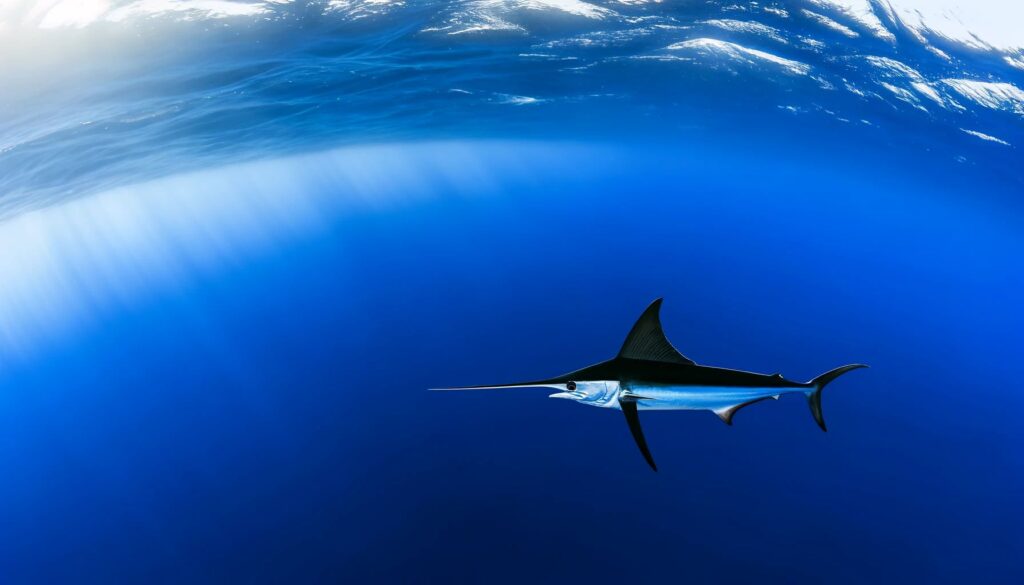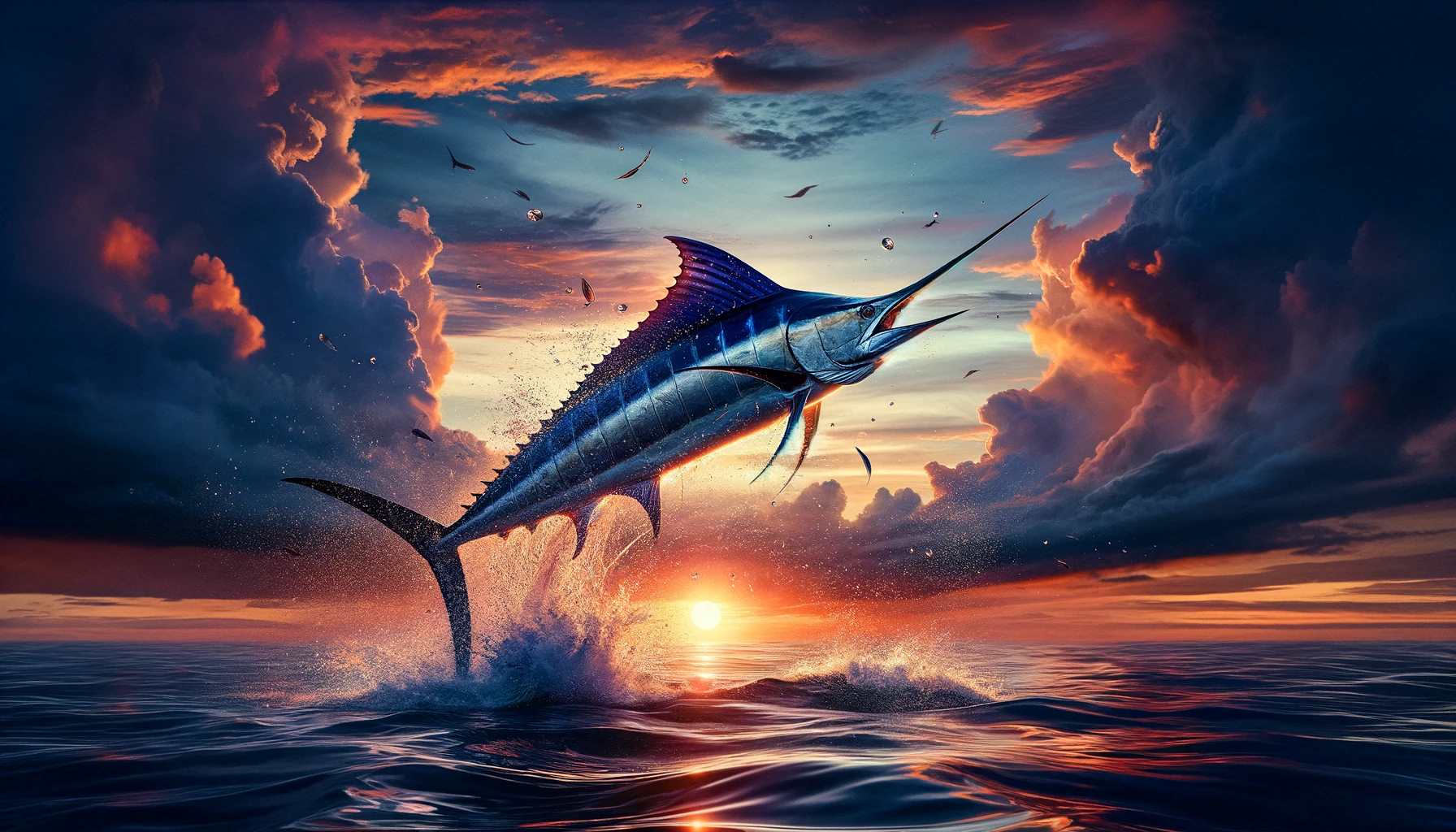This post contains affiliate links.
Key Takeaways
- Discover the morphological differences that set swordfish apart from marlin.
- Learn about the unique hunting tactics of marlins, including their color-changing behavior during group hunts1.
- Understand the significant growth and life span variations within the billfish family, with blue marlin being the largest and longest-lived2.
- Explore how sailfish, despite their frequency along the coast, exhibit unique patterns in early growth compared to their billfish relatives2.
- Grasp the importance of these magnificent creatures in maritime culture and the sportfishing community.
Introduction to Billfish
Embark on an adventure into the fascinating world of billfish, where the swordfish vs marlin battle unfolds. These creatures, with a history of over 71 million years3, reign supreme in the sportfishing world. Marlin come in 11 varieties3, each navigating the seas with grace.On the other hand, the swordfish stands out with its unique flat bill. It cuts through both warm and cool waters with ease3. Truly, it’s a force of the ocean’s deep.The swordfish is a master in the water, racing at up to 68 miles per hour3. Marlin, with their rounded bills, skillfully hunt their prey. These ocean gladiators are majestic3. Anglers play a key role in conserving these species, ensuring their future2.Sailfish are commonly caught off South Carolina, usually weighing about 35 pounds. Yet, some can reach 75 pounds2. Blue marlin, especially females, can grow up to 1,800 pounds, showcasing their strength2.Lesser-known, the longbill spearfish averages 20 to 25 pounds. It dwells quietly in the ocean’s depths2. Sadly, longlining catches about 85% of these billfish in the Western North Atlantic2.| Species | Weight | Annual Catches in South Carolina | Max Length Growth (First Year) |
|---|---|---|---|
| Blue Marlin | 65-1,800 lbs2 | 70-802 | Not Applicable |
| White Marlin | Average 45 lbs2 | Not Applicable | 20-30 lbs2 |
| Sailfish | Average 35 lbs2 | 80-1002 | 72 inches2 |
| Longbill Spearfish | 20-25 lbs2 | Not Applicable | Not Applicable |
- Billfish Species: With Male and Female actors, flashes of color, and sharp bills, Drama runs deep.
- Speed and Predation: They’re not just cruising; they’re chasing down performances with ferocity and flair.
- Conservation Efforts: The stage may be under siege, but conservationists are scripting a hopeful act.2
Distinguishing Features: Anatomy of Swordfish and Marlin
Let’s dive into the underwater world to see how swordfish and marlin differ. We’ll explore everything from their sleek bodies to where they live. First, we’ll look at their unique “swords” and bodies that make them top predators in the ocean.Bill and Body Shape
The swordfish has a long “sword” that can be a third of its body size. This “sword” helps in hunting, making it different from the marlin’s sharper bill . Swordfish are built for deep waters, with big, elongated bodies. Marlins, however, are shaped for speed, making them quick hunters5.
. Swordfish are built for deep waters, with big, elongated bodies. Marlins, however, are shaped for speed, making them quick hunters5.Dorsal Fin Comparison
Looking up, you’ll notice differences in their dorsal fins too. Swordfish have a tall, shark-like fin helping them move smoothly. Marlins have a flexible dorsal fin that stands out in shallow tropical waters. This difference between their fins shows how their living habitats contrast5.Skin and Scale Variations
As they grow, swordfish lose their scales and teeth, unlike marlin. This unique change helps swordfish grow large and hunt diverse prey. Marlin keep their scales, which aids in their varied diet6.| Swordfish | Marlin |
|---|---|
| Maximum 177 inches (455 cm) in length5 | Selective feeder on prey species6 |
| Maximum 1,400 lbs (650 kg) in weight5 | Feeds on a wider range of similarly sized prey6 |
| Sexual maturity at 5-6 years of age5 | Subtler meat taste often enjoyed raw6 |
| Larger females, with specimens over 300 lbs (140 kg)5 | Flamboyant dorsal fin for show in tropical waters5 |
Behaviors and Hunting Tactics
The debate of swordfish vs marlin fishing techniques unveils how these sea warriors differ. Marlins chase prey with incredible speed, while swordfish hunt with stealth in the deep7. This crucial difference shapes their hunting strategies and their appeal to fishers.Swordfish engage in remarkable migrations and hunt in the ocean’s deep, dark layers. They dive between 400 to 600m during daylight and surface at night8. Their ability to keep a high metabolic rate and adapt to various water temperatures aids their hunting78.Marlins prefer the warmer waters above the thermocline for their hunting. They display powerful tailbeats and maintain a high metabolism7. They are known for their acrobatic hunting style, unlike the stealthy swordfish.Conservation has become crucial for these species due to past overfishing. Efforts, especially targeting longliners, have helped North Atlantic swordfish numbers recover9. This success excites sports fishermen around the world.This underwater struggle fascinates us with each leap and plunge of these fish. The victor in mightiness varies, yet knowing their behaviors and tactics is vital. This knowledge shapes a fisherman’s approach, whether targeting swordfish or marlin.Swordfish vs Marlin: Size and Physical Capabilities
Exploring the ocean’s rivalry between swordfish and marlin shows us something amazing. We learn about their size and how well they move in water. Their skills highlight the wonders of marine biology and the challenges they face from fishing and environmental changes.
Maximum Size Comparisons
Looking at the massive sizes of swordfish and marlin is impressive. Swordfish can grow up to twelve feet long and weigh around 1,400 pounds. On the other hand, Pacific black marlin can reach 16 feet and weigh about 1,500 pounds. These numbers not only amaze us but also tell an important story about their role in the ecosystem1011.Speed in the Water
Comparing the speed of swordfish and marlin is thrilling. They can both race through the water at 50 mph because of their hunting skills. The blue marlin, especially, is one of the fastest, second only to the sailfish. Their speed is vital for staying on top in the ocean1011.Understanding the differences between swordfish and marlin deepens our appreciation of their power. Over 1,080 PSAT tags have given us insight into their lives. They show how the swordfish is bouncing back in the North Atlantic but struggling in the Mediterranean, just like the blue marlin10.Swordfish and marlin’s lives are tightly linked to the health of the ocean. Lowering bycatch and improving fishing methods offer hope for their future. Their physical prowess stands as a marvel of evolution. It pushes us to keep exploring the mysteries of the deep sea11.Habitats and Migrations: Where They Roam
In the vast ocean, swordfish and marlin live in very different places. Knowing where they live is about understanding their life. Marlins enjoy warm waters, while swordfish dive into the cooler depths below.Each species follows a path shaped by instinct and the need to survive.- Marlin: They love the warm waters of the tropics. White marlin can be found from Cape Cod to Cape Hatteras. They sometimes dive deeper than 325 feet. They roam waters from 45°N to 45°S in the Atlantic and reach 35°S in the east12.
- Swordfish: Swordfish travel far, like deep-sea explorers. They can move up to 3275 km, often in water around 23-27°C. This movement might be for breeding. They link tropical and temperate zones in the southwest Pacific, but not beyond13.
| Species | Max Length | Max Weight | Preferred Depths | Typical Surface Temperature Range |
|---|---|---|---|---|
| White Marlin | 110 inches (280 cm) | 180 pounds | >325 feet | 71°F – 83°F (20°C – 29°C) |
| Swordfish | N/A | N/A | 45.8m – 494.9m | 68°F – 80°F (23°C – 27°C) |
Culinary Delights: Comparing Swordfish and Marlin Dishes
Looking for the perfect seafood dinner often leads to choosing between swordfish and marlin. Both offer unique tastes and health benefits that appeal to different palates15. In upscale seafood restaurants, swordfish is more popular, being chosen about 60% of the time15.When talking about flavor, swordfish is like the heavyweight champion. Its meaty texture wins the hearts of many, making it preferred for grilling by a vast majority of fish enthusiasts15.Marlin, on the other hand, offers a strong nutritional value with 30% more omega-3s than swordfish15. This makes it a choice for those focused on health benefits in their meals15.
Swordfish vs Marlin Meat
The competition between swordfish and marlin is not only about taste but also market value. Swordfish costs about 15% more per pound in luxurious markets, showcasing its higher demand and popularity in special grilling recipes15.Popular Cooking Methods
Chefs prefer swordfish for creating dishes with a smoky flavor. Grilled swordfish appears in about 80% of grilled seafood menus, displaying the skill of combining flavor and cooking technique15. Grilling spans across various cuisines, from informal backyard BBQs to formal dinners16.Marlin may not be as popular on the grill, but it shines in Japanese sashimi, searing, and Caribbean spices. These dishes offer a touch of exotic taste, pleasing those looking for something different1516.| Culinary Aspect | Swordfish | Marlin |
|---|---|---|
| Preference in Upscale Restaurants | 60% Higher | 40%15 |
| Popular Cooking Methods | Grilling (80%) | Raw (Sashimi), Seared15 |
| Avg. Price per Pound | 15% Higher | Competitive15 |
| Omega-3 Levels | Lower | 30% Higher15 |
| Popularity Among Consumers | 75% Favorability | 25% Favorability15 |
Conclusion
The swordfish vs marlin debate is like a sea tale full of wonders. Look at the Atlantic blue marlin. It’s at risk but can weigh up to 820 kg (3), inspiring those who love sportfishing. Then, there’s the swift sailfish, zipping through water as fast as 68 miles per hour (3).These fish have their own stories in the ocean narrative. They live in various places, from sunny shallows to deep, cool waters. Their hunting skills are a result of 71 million years of evolution (3). Sadly, some, like the Atlantic white marlin, are now dangerously few (17).Billfish tales mix athletic feats with conservation. Food lovers praise swordfish steaks and marlin sashimi. Chefs are getting creative to honor these sea giants. Through genetic studies and tagging, we’re learning about their travels and habits. This knowledge might help us protect them better (18).So, as we explore the ocean’s mysteries, let’s honor these giants. The swordfish and marlin stories are not just about fishing. They remind us to balance our desires with the ocean’s health (3)(17)(18).FAQ
What are the key differences between swordfish and marlin?
How can you distinguish a swordfish from a marlin when you see one?
Which grows larger, a swordfish or a marlin?
What habitats do swordfish and marlin prefer?
How do the cooking methods differ for swordfish versus marlin?
Are the fishing techniques for swordfish and marlin similar?
Does swordfish or marlin meat have a better taste?
How are swordfish and marlin related to each other?
What is the maximum speed of swordfish and marlin
Can you differentiate swordfish and marlin by their speed?
Source Links
- https://www.sciencedaily.com/releases/2024/02/240226114549.htm
- https://www.dnr.sc.gov/marine/pub/seascience/billfish.html
- https://en.wikipedia.org/wiki/Billfish
- https://billfish.org/education/did-you-know/
- https://www.floridamuseum.ufl.edu/discover-fish/species-profiles/xiphias-gladius/
- https://www.frdc.com.au/fish-vol-29-3/marlin-swordfish-and-sawsharks-feature-winning-presentations
- https://www.nature.com/articles/s41598-023-28748-0
- https://www.dpi.nsw.gov.au/fishing/recreational/resources/fish-tagging/the-great-swordfish-race
- https://hp.fishtrack.com/article/swordfish
- https://animalbiotelemetry.biomedcentral.com/articles/10.1186/s40317-014-0020-9
- https://www.ncbi.nlm.nih.gov/pmc/articles/PMC9934375/
- https://www.floridamuseum.ufl.edu/discover-fish/species-profiles/kajikia-albida/
- https://www.nature.com/articles/s41598-023-38744-z
- https://www.frontiersin.org/articles/10.3389/fevo.2019.00271
- https://www.washingtonpost.com/archive/lifestyle/2003/05/30/go-fish/dc16d454-781d-49d1-95f6-8f000bbcbbc0/
- https://www.escoffier.edu/blog/culinary-arts/the-essential-glossary-of-cooking-terms-for-the-culinary-arts/
- https://media.fisheries.noaa.gov/dam-migration/white_marlin_petition_feb_2012-accessible.pdf
- https://www.ncbi.nlm.nih.gov/pmc/articles/PMC7394060/
This post contains affiliate links.

